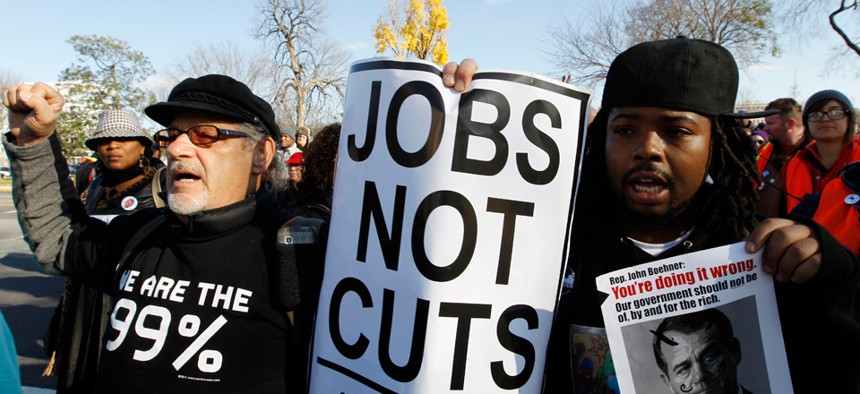Our Fragile Economy Still Needs Time to Gather Its Strength
We feel better, but nowhere near good.
The best thing about long airline flights is the time they offer for delving into long reports, uninterrupted by phone calls and emails. This includes reports from economic departments of investment houses—economic consulting firms and groups that advise institutional investors—that give a texture to what is going on in the economy that can shape public opinion. One of my favorite lines about politics is from Yale political scientist and statistician Edward Tufte in his book Political Control of the Economy: "When you think economics, think elections; when you think elections, think economics."
Americans remain pretty pessimistic about the economy. The National Bureau of Economic Research calculates that the most recent recession began in December 2007 and ended in June 2009. But that is certainly news to most Americans. In a March NBC News/Wall Street Journal poll, 57 percent of respondents said they believe we are still in a recession, while 41 percent said we are not. Indeed, in the seven times that NBC/WSJ pollsters have asked the question since the latter half of 2001, a majority of Americans have felt that we were in a recession.
While consumer confidence is on the rise and pretty close to the highest it has been since the last recession began, we are nowhere near the levels of optimism and comfort that Americans felt during the period of 1992 until this latest recession began in late 2007. We feel better, but nowhere near good. The recent economic reports that we only had a one-tenth of a percentage point increase in the real gross domestic product is attributed to an unusually harsh winter; but a vibrant economy doesn't sustain that kind of hit from a tough winter alone. As Mesirow Financial's Chief Economist Diane Swonk put it in a recent report to clients: "The economy came to a virtual standstill in the first quarter [of 2014], adding insult to injury to an economy still struggling to recover." She added that it was "reflective of a fundamental weakening in a recovery that was already compromised." This was and remains a very fragile economy.
The monthly survey of top economists conducted by Blue Chip Economic Indicators projects that the economy, as measured by change in real GDP, will likely grow at a rate of 3.4 percent for the ongoing second quarter of this year, then 3.0 and 3.1 percent for the third and fourth quarters, respectively. And projections for 2015 remain basically at the 3.0 percent level. Obviously, this is far better growth than we have had during recessions; looking back over the last three-quarters of a century, mid-to-high single digits is more the norm, so the economy will likely be growing—but compared with the pain we have gone through, not at nearly the rate we need and would like to have.
With projections calling for growth—but nothing like the impressive growth we have seen in previous eras—businesses are slow to risk huge investments in new plants and equipment. To paraphrase economist Michael Drury of McVean Trading and Investments, without a surge in capital spending—which is not happening—this economic cycle will remain lackluster, but last longer. Manufacturing and employment in that sector is picking up strongly, but caution remains.
Cornerstone Macro, a New York-based firm that advises its Wall Street clients on economics, policy, and investment strategy, said in a recent report that the manufacturing workweek is near a record high, and manufacturing wages are now on the increase after a stomach-churning plunge during the 2008 recession. The manufacturing employment rate for April was 5.6 percent, the largest increase in almost 30 years. Citing figures from the payroll firm ADP, the employment rate for small businesses—organizations with fewer than 50 workers—is at a record high. Now almost 50 million people work for small businesses, almost double those working for large businesses of 500 or more employees.
Hiring numbers for small, medium, and large firms are doing well, but not all of the unemployed have the skills for this new economy. The labor-participation rate (the percentage of the population working) is still languishing, and long-term unemployment remains a critical problem. Sadly, the longer people are unemployed, the more their skills and marketability atrophy, and the harder it is for them to find a new job. We were in a pretty deep hole during the recession, followed by an exceedingly sluggish recovery.
Much of the good news in manufacturing is linked to the energy renaissance coming from the oil and gas sector. The International Energy Agency projects that the U.S. will surpass Russia and Saudi Arabia to become the world's top oil producer by 2015.
Energy Information Administration figures show that U.S. crude-oil inventories are the highest since 1931, currently at almost 400 million barrels. This is roughly a third more than 10 years ago, and far greater than the 250 million during the energy crisis of the 1970's. U.S. oil production is now at double the amount of oil we import from OPEC, a huge plus for the United States for both economic and geopolitical reasons. Heading into the recession that began in December 2007, imports far outstripped production.
The bottom line is that while there is considerable good news, the bad news was so bad for so long, we need much better news for a much longer period of time.







